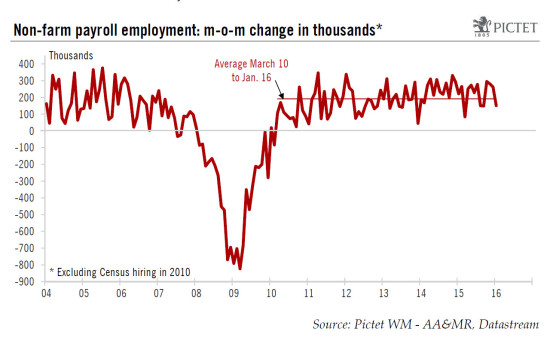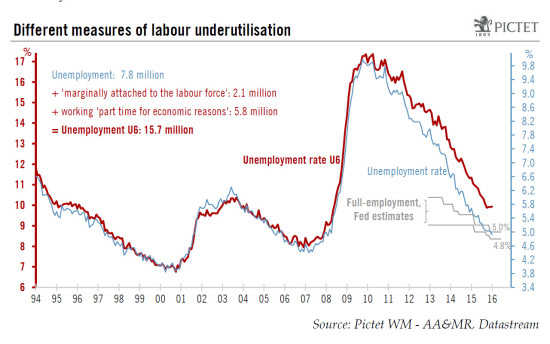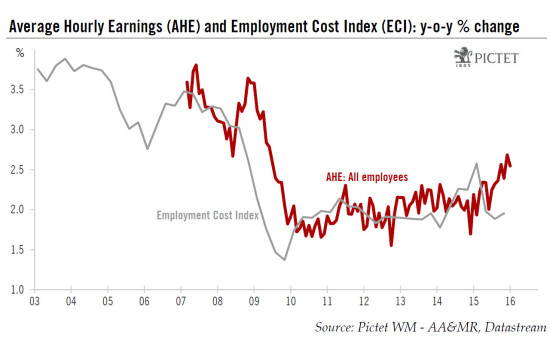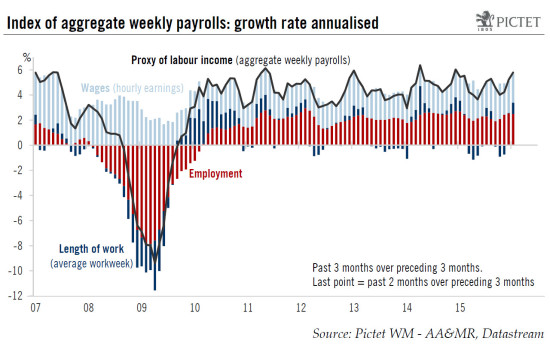January’s employment report showed soft job gains. However, this was above all a statistical payback. Unemployment dropped, wage increases were higher than expected and the average workweek inched up. The overall situation remains healthy in the US labour market. Non-farm payroll employment rose by a soft 151,000 m-o-m in January, below consensus expectations (190,000). December’s figure was revised down (from 292,000 to 262,000), but November’s number was revised up (from 252,000 to 280,000). Cumulative net revisions for the previous two months thus worked out at a marginal -2,000. This weak number for January should be put in its proper context. Job creations are very volatile in the short run (see chart below), and they were surprisingly strong in Q4, partly due to temporary factors (unusually warm weather and some residual seasonality in the hiring of messengers and couriers). Therefore, some downward payback in January does not appear particularly surprising. Nevertheless, over the past three months, job creation averaged 231,000, not a bad reading at all, a number actually similar to what was registered on average over the first 10 months of 2015 (219,000 per month), and above the average number recorded since employment bottomed out in February 2010 (191,000). Between Q4 2015 and January 2016, employment grew by 1.
Topics:
Bernard Lambert considers the following as important: employment, growth, Macroview, Non-farm payrolls, United Staes
This could be interesting, too:
Marc Chandler writes No, Chicken Little, the Sky is Not Falling
Douglas R. Terry, CFA writes Macro: Challenger Job Cuts — Improvement throughout the year
Marc Chandler writes Week Ahead: More Evidence US Consumption and Output are Expanding, and RBNZ and Norges Bank to Hike
Jeffrey P. Snider writes Simple Economics and Money Math
January’s employment report showed soft job gains. However, this was above all a statistical payback.
Unemployment dropped, wage increases were higher than expected and the average workweek inched up. The overall situation remains healthy in the US labour market. Non-farm payroll employment rose by a soft 151,000 m-o-m in January, below consensus expectations (190,000). December’s figure was revised down (from 292,000 to 262,000), but November’s number was revised up (from 252,000 to 280,000). Cumulative net revisions for the previous two months thus worked out at a marginal -2,000.
This weak number for January should be put in its proper context. Job creations are very volatile in the short run (see chart below), and they were surprisingly strong in Q4, partly due to temporary factors (unusually warm weather and some residual seasonality in the hiring of messengers and couriers). Therefore, some downward payback in January does not appear particularly surprising.
Nevertheless, over the past three months, job creation averaged 231,000, not a bad reading at all, a number actually similar to what was registered on average over the first 10 months of 2015 (219,000 per month), and above the average number recorded since employment bottomed out in February 2010 (191,000). Between Q4 2015 and January 2016, employment grew by 1.8% annualised, a pretty solid rate considering economic activity probably grew by less than that over the same period. In any case, with the economy approaching full employment, a gradual slowdown in job creation should occur during the course of this year, hopefully accompanied by some improvement in productivity growth.
In addition to the usual previous two months’ revision, today’s employment report included longer-term (5 years) revisions reflecting the annual benchmark adjustment and updated seasonal factors. The level of employment in December was revised slightly down (by less than 0.1%), but job creations in 2015 were revised slightly up by a cumulative 85,000 (7,000 per month on average).
Unemployment rate falls below 5.0%
Meanwhile, the unemployment rate declined from 5.0% in December to 4.9% in January (4.92% before rounding). This represents a new record eight-year low. Consensus expectations were for an unchanged rate.
A more in-depth look at the household survey (which is the basis for the unemployment rate calculations) is more difficult than usual today because last month’s data are based on updated population estimates, whereas December’s figures remain unrevised. Nevertheless, the employment measure of the household survey (adjusted for population control effects mentioned above) – in any case an often very volatile statistic – increased by a massive 409,000 m-o-m in January, whilst, at the same time, the size of the labour force rose by less (284,000). The end-result was that the number of unemployed declined by 125,000 (284,000 minus 409,000). The decline in unemployment was therefore linked to strong employment growth, not to a fall in the participation rate. Quite the opposite actually: this happened despite an increase in the participation rate from 62.6% to 62.7%.
In any case, at 4.9%, the unemployment rate is now in the middle of the range that the Fed feels corresponds to full employment (4.8%-5.0%). Moreover, it is worth remembering that this latter range was lowered from 4.9%-5.2% as recently as December.
The Fed has repeated many times that the unemployment rate probably underestimates the amount of resources available in the labour market. However, even if we consider a wider measure of unemployment, i.e. the U6 measure – which includes (1) employees working part-time, but who would prefer a full-time job, and (2) people who want a job, are available for work, have looked for a job sometime over the past 12 months, but did not do so during the current survey week and were therefore not counted as unemployed – it has fallen heavily over the past few years. Admittedly, it has remained stable at 9.9% in Q4 2015, and this stability continued in January. However, the decline recorded year-over-year certainly remained quite marked (1.4 points) and, on this yardstick too, full employment does not look all that far away (see chart above).
Strong m-o-m wage increase in January
Meanwhile, average hourly earnings rose by a strong 0.5% m-o-m in January, a result noticeably above consensus estimates (+0.3%). However, this follows a flat monthly reading in December and, due to an unfavourable base effect (a monthly increase of 0.6% in January 2015), on a y-o-y basis wage increases actually fell back from 2.7% in December (revised up from 2.5%) to 2.5% in January. This series is quite volatile (see chart below), and data for the past five years were revised today. Nevertheless, according to these statistics, it seems that the pace of wage increases picked up somewhat during the course of the past year or so. Meanwhile, however, the quarterly Employment Cost Index (ECI) – admittedly the most reliable measure of wages and salaries – is not pointing to any noticeable acceleration in wage increases. In any event, we continue to expect wage increases to gradually pick up over the coming few quarters.
Encouragingly as well, the average workweek increased from 34.5 hours in December to 34.6 hours in January. In terms of total hours worked, an increase of 0.1 hours is equivalent to some 350,000 jobs being created. As a consequence, the index of ‘aggregate weekly payrolls’ (calculated as a product of aggregate hours worked and average hourly earnings) rose by a strong 0.9% m-o-m in January. The end-result was that this index – which is a good proxy for nominal household income coming in the form of private wages and salaries – grew by a very strong 7.3% annualised between Q4 and January, after +4.2% q-o-q in Q4 and +5.3% in Q3. This remains a supportive development for growth in household income in Q1, and for consumer spending.
Not such a weak employment report
Today’s employment report showed soft payroll gains last month, but this followed high numbers over the previous three months. Moreover, wage data were quite solid and the proxy for household income rose sharply m‑o‑m. Most economic data published recently were quite disappointing, and there are clear downward risks on US growth. However, we continue to believe that a sharp downturn will be avoided, and today’s employment report does not change this view. Our forecasts that GDP growth will reach 2.0% q-o-q annualised in Q1 and 2.0% as well on average in 2016 remain unchanged.
Most comments by Fed members were relatively ‘dovish’ this week. All this reinforced our expectation that the Fed will remain on hold in March and hike ‘only’ twice this year, once in June and once in December.




